Have you ever found yourself devouring a plate of General Tso’s chicken and wondering, “What exactly is this magical sauce that makes me crave Chinese takeout at 2 AM?” Well, you’re not alone! As someone who’s spent countless hours trying to replicate that perfect balance of sweet, spicy, and savory flavors, I’ve got the inside scoop on what makes this iconic sauce so darn addictive.
General Tso’s sauce is the heart and soul of one of America’s most beloved Chinese-American dishes And guess what? You can totally make it at home in just 10 minutes with pantry staples you probably already have!
What Exactly is General Tso’s Sauce?
General Tso’s sauce is a rich thick glossy sauce that perfectly balances sweet, savory, tangy, and spicy flavors. It’s what transforms simple fried chicken pieces into that mouthwatering dish we all know and love. The sauce originated from Chinese-American cuisine and is named after a Chinese military leader from the Qing dynasty, Zuo Zongtang (or Tso Tsungtang when romanized).
The sauce we know today was reportedly developed in the 1970s by Chinese immigrants in America who tweaked the original recipe to better suit American tastes – making it a bit sweeter than the original Hunanese version which was considerably spicier.
The Key Ingredients in General Tso’s Sauce
After examining several authentic recipes, I’ve found that a proper General Tso’s sauce typically contains:
Base Ingredients:
- Soy sauce (preferably low-sodium)
- Rice vinegar (for that tangy kick)
- Hoisin sauce (a key flavor component)
- Chicken broth or water
- Sugar (both white and brown for depth of sweetness)
- Sesame oil (for that distinctive nutty flavor)
Aromatics and Spice:
- Fresh ginger (minced or grated)
- Fresh garlic (or garlic powder in a pinch)
- Red pepper flakes (for that signature heat)
Thickener:
- Cornstarch (mixed with water to create a slurry)
What makes General Tso’s sauce different from other Chinese sauces like sweet and sour is its complexity. While both are sweet and savory, General Tso’s sauce has a deeper umami flavor from the hoisin sauce and isn’t as acidic as sweet and sour sauce. General Tso’s sauce is also darker in color compared to the bright red of sweet and sour sauce.
How to Make General Tso’s Sauce at Home
I’ve got great news – this sauce is ridiculously easy to make! Here’s a simple recipe that’ll give you that authentic restaurant taste:
Quick General Tso’s Sauce Recipe
Ingredients:
- 3-4 tablespoons rice vinegar
- 4-5 tablespoons soy sauce (low sodium preferred)
- 2 tablespoons hoisin sauce
- 1/2 cup water or chicken broth
- 1 teaspoon sesame oil
- 3-4 tablespoons white sugar
- 3 tablespoons brown sugar
- 1 teaspoon fresh ginger, minced
- 2-3 cloves garlic, minced (or 1/2 teaspoon garlic powder)
- 1/4-1/2 teaspoon red pepper flakes (adjust to your spice preference)
- 1-2 tablespoons cornstarch mixed with 1-2 tablespoons water (for thickening)
Instructions:
- In a bowl or measuring cup, combine all ingredients except the cornstarch slurry.
- Whisk until the sugar is completely dissolved.
- When ready to use, give it a good shake or stir as the ingredients may separate.
- To thicken, pour the sauce into a pan over medium heat.
- Add the cornstarch slurry while whisking continuously.
- Cook for about 3-5 minutes until the sauce thickens to a glossy consistency.
And voilà! You’ve got yourself some authentic General Tso’s sauce ready to transform ordinary chicken into something extraordinary!
Expert Tips for Perfect General Tso’s Sauce
Here are some pro tips I’ve learned from making this sauce countless times:
- Fresh is best: Use fresh ginger and garlic whenever possible. The flavor difference is noticeable compared to the powdered versions.
- Taste and adjust: Everyone’s preference for sweet vs. spicy is different. Start with less sugar and pepper flakes, then adjust to your liking.
- Low sodium soy sauce: This gives you more control over the saltiness of your final sauce.
- Substitute smart: If you don’t have rice vinegar, white wine vinegar can work in a pinch. No hoisin sauce? Try mixing barbecue sauce with a bit of Sriracha and Chinese five-spice powder.
- Thicken right: Add the cornstarch slurry when the sauce is already hot and simmer for a few minutes to activate the thickening properties and cook out the starchy taste.
How to Use General Tso’s Sauce
This versatile sauce isn’t just for chicken! Here are some tasty ways to use it:
- Classic General Tso’s Chicken: Toss with crispy fried chicken pieces
- Stir-fry sauce: Add to any vegetable or protein stir-fry
- Marinade: Use to marinate chicken, pork, beef, or tofu before cooking
- Dipping sauce: Great for egg rolls, dumplings, or even as a drizzle for crispy tofu
- Glaze: Brush onto grilled meats during the last few minutes of cooking
Make-Ahead and Storage Tips
One of the best things about this sauce is that you can make a big batch and save it for later:
- Refrigerator: Store in an airtight container for up to 3 weeks
- Freezer: Freeze in small portions for up to 3 months
- Reheating: May need to add a splash of water when reheating as it thickens considerably when cold
Common Questions About General Tso’s Sauce
Is General Tso’s sauce the same as sweet and sour sauce?
No! While both are sweet and savory, they are NOT the same. General Tso’s sauce is darker, more savory with umami flavors from hoisin sauce, and has a spicy kick. Sweet and sour sauce is brighter red, more acidic, often contains pineapple juice, and gets its umami from ketchup.
Why is my General Tso’s sauce too watery?
The sauce needs to be simmered long enough to reduce and thicken. If it’s still too thin, mix a teaspoon of cornstarch with two teaspoons of cold water and add to the simmering sauce. Remember, the sauce will thicken more as it cools.
Can I make General Tso’s sauce gluten-free?
Yes! Use tamari instead of soy sauce and make sure your hoisin sauce is gluten-free.
Can I reduce the sugar?
Absolutely. You can cut back on the sugar or substitute with honey, agave syrup, or a sugar alternative like erythritol or monk fruit sweetener.
How spicy is authentic General Tso’s sauce?
Traditional General Tso’s sauce has a noticeable spicy kick, but the Americanized version tends to be milder. Adjust the red pepper flakes to your preference.
The Bottom Line on General Tso’s Sauce
The magic of General Tso’s sauce lies in its perfect balance of flavors – sweet, savory, tangy, and spicy all rolled into one glossy, thick sauce that clings beautifully to crispy chicken pieces. Once you’ve mastered making this sauce at home, you might find yourself skipping the takeout altogether!
I make a big batch of this sauce every couple of weeks and store it in the fridge. It’s my secret weapon for turning an ordinary weeknight dinner into something special with minimal effort. Trust me, your family will be impressed when you whip up restaurant-quality General Tso’s chicken in less time than it takes for delivery to arrive!
So next time you’re craving that distinctive flavor, don’t reach for the phone – reach for your pantry ingredients instead. Your taste buds (and wallet) will thank you!
Have you tried making General Tso’s sauce at home? What’s your favorite way to use it? I’d love to hear your experiences in the comments below!
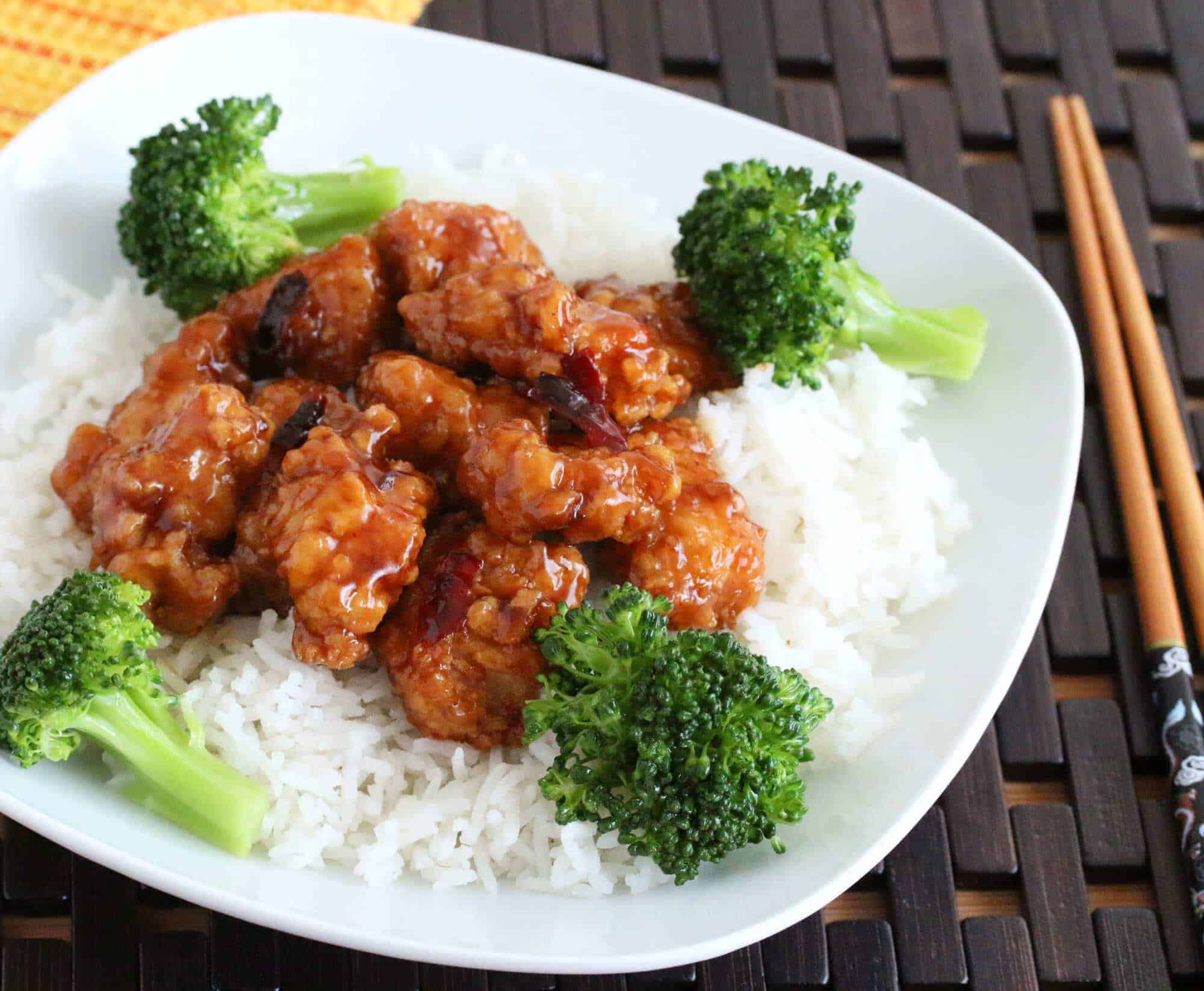
What you will need
Over the years, I’ve loved eating at traditional Chinese restaurants in New York and New Jersey. Those experiences helped me understand how truly authentic Chinese recipes should taste, especially when it comes to sauces. To make this one at home, you’ll just need a few simple staples like:
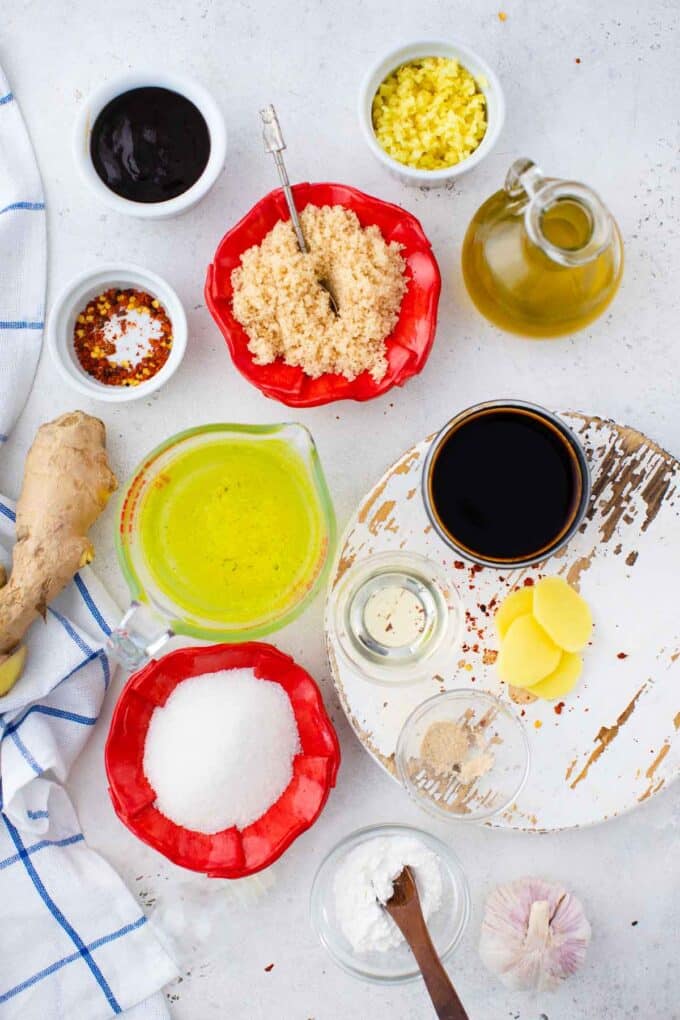
- Liquid base: I use a mix of rice vinegar, soy sauce, hoisin sauce, and low-sodium chicken broth to build the savory, tangy base of the sauce.
- Sweeteners: Both white and brown sugar go in to create that classic sweet and sticky balance that makes General Tso sauce so crave-worthy.
- Aromatics and spice: Minced ginger, garlic or garlic powder, and a pinch of red pepper flakes bring depth, and just the right amount of heat.
- Thickener: A little cornstarch is all it takes to thicken the sauce into that glossy, clingy texture.
Mix in all the sauce ingredients: This is truly one of the easiest recipes you’ll ever make, and trust me, it’s nearly impossible to mess up. I simply combine all the ingredients in a pot, no need to worry about the order. To help visualize, I’ve added an below. Then, I cook it over medium-high heat for about 3 to 5 minutes, stirring constantly until the sauce thickens perfectly.
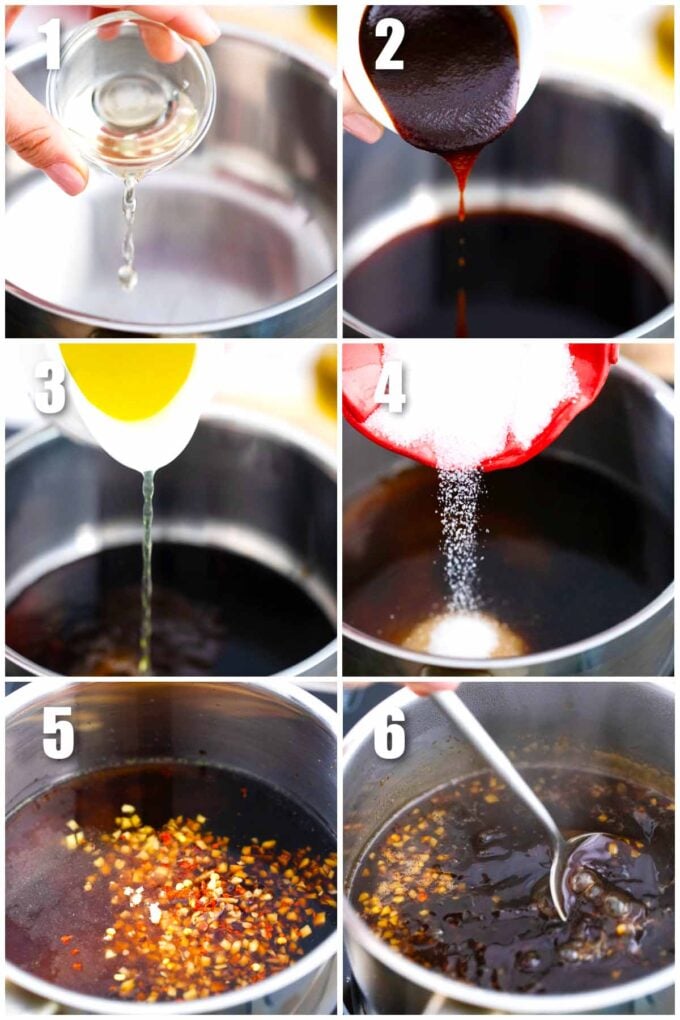
Thicken and serve: Let the sauce thicken for about 5 minutes, then remove it from the heat. You can use it right away, or if you’re not using it immediately, cool it thoroughly and store it in a clean container or jar for later use.
When I first started making sauces at home, I realized the biggest difference between store-bought and homemade was the use of fresh aromatics. I always make sure to use fresh garlic, ginger, and green onions whenever I can. These ingredients instantly elevate the flavors, giving the sauce that sharp, vibrant kick you just don’t get from a jar.
- I always whisk the sauce ingredients well before cooking. This helps ensure everything blends smoothly and prevents lumps from forming when thickening with cornstarch.
- Hoisin sauce adds that authentic Chinese flavor to dishes, but if you don’t have it, you can mix barbecue sauce with Sriracha and a little Chinese five-spice powder. However, I highly recommend picking up hoisin, it’s used in so many Chinese recipes and lasts a year in the fridge.
- Not everyone loves garlic, so if you prefer a subtle flavor, go for garlic powder. But if you enjoy a stronger garlic kick, fresh minced garlic is the way to go.
- Chinkiang vinegar is a great alternative to rice vinegar if you want something with a deeper flavor. I like to use it in some of my recipes for a more complex taste.
- Gluten-free option: Swap the soy sauce with tamari and use a gluten-free hoisin sauce. This way, you can enjoy all the flavor without worrying about gluten.
- Sugar alternatives: The sugar in my recipe can be replaced with 6 tablespoons of honey or agave. If you prefer sugar substitutes, you can use 6 tablespoons of erythritol or monk fruit sugar for a lower-carb option. These alternatives work just as well to sweeten the sauce without sacrificing flavor!
- Make it spicy: Want more heat? Add extra red pepper flakes or some chopped fresh chili to give the sauce an even spicier kick.
This sauce is incredibly versatile. I often use it in stir-fries with meat, veggies, or whatever I have on hand. It’s also fantastic as a dipping sauce for avocado egg rolls or drizzle it on top of my crispy tofu salad.
It works wonderfully as a marinade for chicken, pork, or beef. I highly recommend using it for baked chicken breasts, roasted pork loin, or even as a glaze for this homemade meatloaf, it adds so much flavor to everything!
- Refrigerator: Once refrigerated, you can use this up within two to three weeks.
- Freezer: If frozen, this can be kept for 3 months. This is especially helpful when you cook a larger batch and refrigerate portions in Ziploc bags to have on hand.
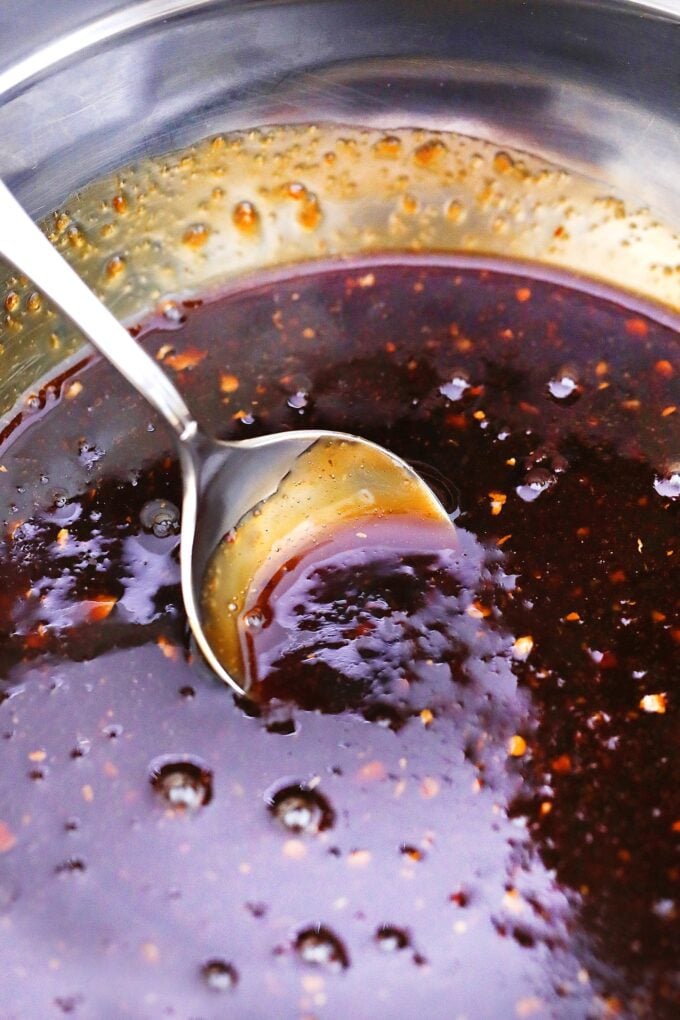
It is used in the famous Chinese takeout dish, General Tso Chicken. It is named after a Chinese leader from the Qing dynasty, Zuo Zongtang, whose romanized name is Tso Tsungtang. History has it that a certain Chef Peng invented the dish and served it in his restaurant in Taiwan. From this original recipe, the Chinese immigrants in the US developed the present-day recipe in the 1970s. The version that we know now is tweaked to please the American palate – a little bit sweeter than the original version which is hotter and of Hunanese influence.
It is the perfect and balanced combination of sweet and savory flavors. It has notes of sour, tangy, and mildly spicy all at once. The sauce has a sticky texture and tends to thicken when refrigerated. It goes hand in hand with crispy chicken and veggies, as served in General Tso Chicken.
That is the case when the sauce was not simmered enough, or a thickener like cornstrach slurry has not been used. I recommend, mixing about a teaspoon of cornstarch with two teaspoons of water, until fully dissolved, and add the mixture to the sauce. Simmer it for a few minutes, and repeat if needed. Keep in mind that the sauce will thicken more once it cools.
While both are sweet and savory sauces, and have some similarities, they are NOT the same. Each one possesses very distinctive features. General Tso Sauce leans more towards the savory palette, with an umami flavor from the Hoisin sauce that is not used in Sweet and Sour Sauce.Sweet and sour sauce is a bit more acidic, sweeter, and not as spicy. Usually, it has some pineapple juice in the ingredient list, and the umami flavor comes from the Ketchup that is added. They also look different visually, with the General Tso being darker and the other almost a bright red color.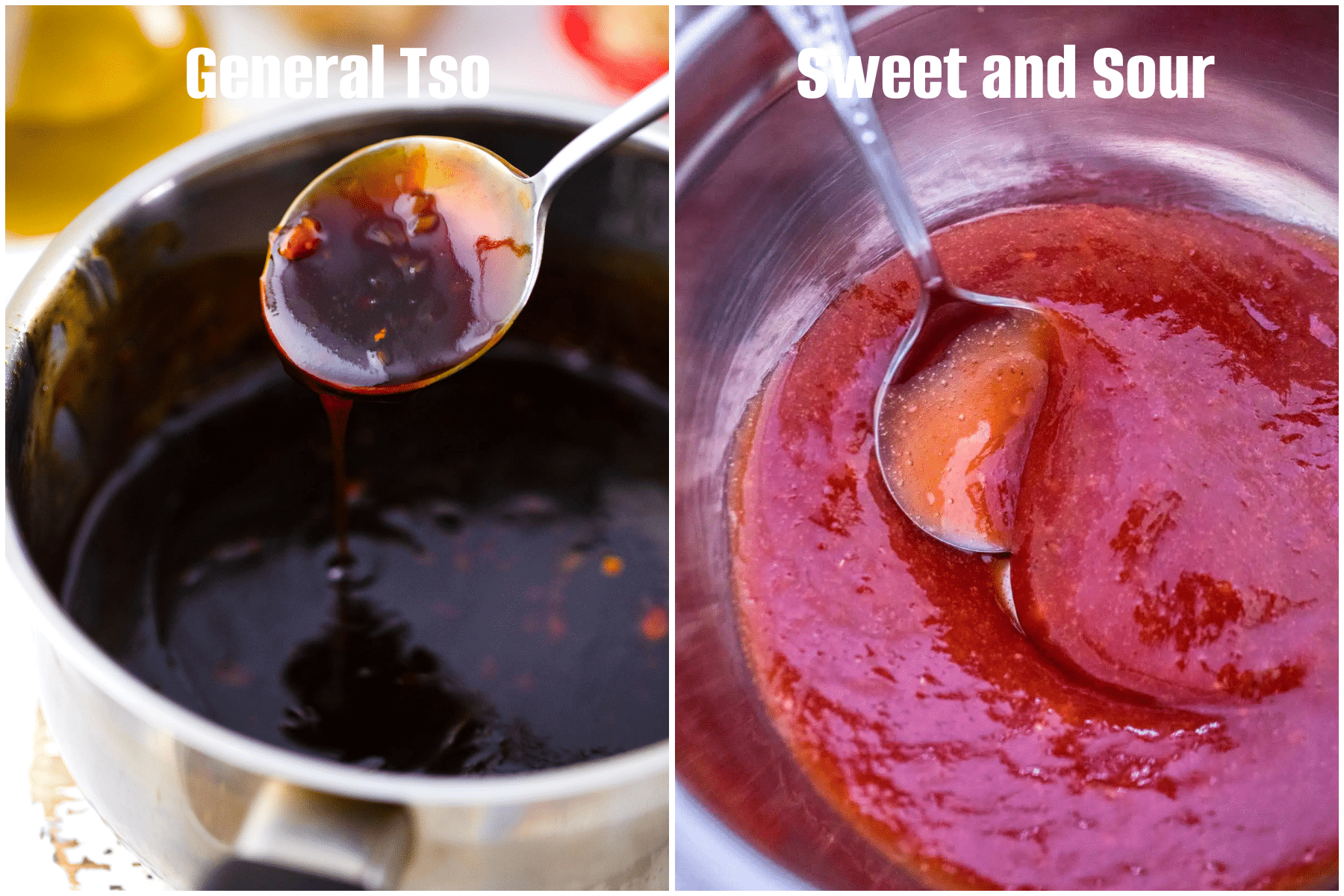
Why you will love this recipe
- So easy you’ll want to make it all the time: I can throw this sauce together in one pot using simple pantry staples like soy sauce, hoisin, rice vinegar, and fresh ginger. It takes just ten minutes and comes out perfect every time.
- Make it once, enjoy it again later: I often double the recipe and freeze some for later. It holds up great and makes dinner prep even faster the next time around.
- Way better than store-bought, no question: This homemade version has way more flavor than anything I’ve tried from a jar. It’s sweet, savory, a little spicy, and full of real ingredients like garlic, ginger, and brown sugar.
- One sauce, endless possibilities: I use it as a stir-fry sauce, a dip, or even a quick glaze for chicken or tofu.
